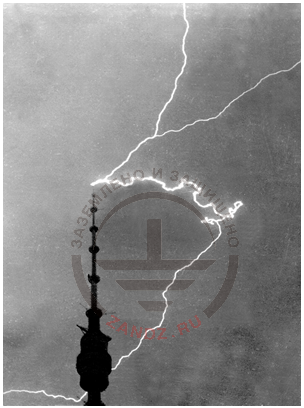The fourth part of the article "Lightning protection at a construction site"
Any construction starts from the zero circle, but the height of the walls grows, and together with it, the requiremenrs to lightning protection grow. As it has just been mentioned, the frequency of lightning strikes increases with the height of the construction (at the extreme - proportionally to the square of height), and the reliability of lightning rods operation reduces. The problem is most accurate in high-rise construction, where the height is the maximal outline dimension. For example, for middle regions of Russia, the number of lightning strikes into the mast 100 m high is close to 1 a year, as for Ostankino tower it will grow to 25-28. Forming the requirements to lightning protection of high-rise objects under construction, it is important to consider not only the frequency of lightning strikes, but their type. It is known, that beside the traditional downstream lightning, starting from the thunder cloud and moving to the ground, there are upstream discharges. They originate from the top of high-rise structures and strive up to the thunder cloud. On a flat surface upstream lightning, as a rule, are characteristic to structures more than 200 m high.

Fig. 5. Upstream lightning from the Ostantino TV-tower
They do not appear from its side surface with the weaker electric field. That is why, upstream lightning are an easy trophy for lightning rods. They are not considered in the estimation of lightning protection operation reliability. Counting the expected number of lightning breakthrough to the protected high-rise building of almost any height, it is necessary to orientate on the downstream discharges. If to apply everything said above to the flat land with any intensity of thunderstorm activity, the probable annual number of downstream lightning into the objects higher than 200-250 m can be approximately estimated as
Nнисх ≈ 0,7nм
where nm - relative density of lightning into the undisturbed ground surface per 1 km2 a year. Thus, admitting for example 1 lightning strike in Тпр years or high-rise construction sites use in the region, where nm = 3 (km3 per year) - 1, the reliability of lightning rods should be
P ≈ 1-(0,7nмTпр)-1≈ 0,99,
whereas in the polar area (hm ≈ 1) the reliability of P can be ≈ 0,97 and in tropic latitudes (hm ≈ 10) it will have to be increased up to 0,997.
E. M. Bazelyan, DEA, professor
Energy Institute named after G.M. Krzyzanowski, Moscow
Read more "5. What kind of lightning protection to orient to?"
See also:
- How to choose lightning rods after all? (article by Professor E.M. Bazelyan)
- Lightning protection of high-rise buildings (article by Professor E.M. Bazelyan)
- Free webinars for designers of grounding and lightning protection
- Grounding and lightning protection projects in dwg, pdf formats
- Free consultations and assistance in calculation of grounding and lightning protection
Related Articles:
 Lightning protection of residential and public buildings - answers to frequently asked questions in the design
Lightning protection of residential and public buildings - answers to frequently asked questions in the design
 6. How to do that?
6. How to do that?

